Homo habilis
|
|
EUGENE M. MCCARTHY, PHD
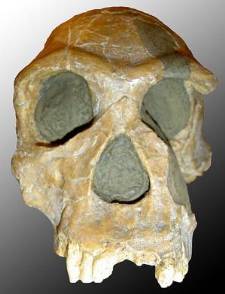
|
| Homo habilis Photo: Wikimedia |
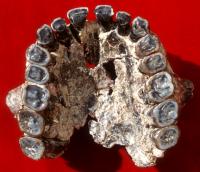
|
| H. habilis maxilla (OH 65)
Image: Wits University
(Enlarged view) |
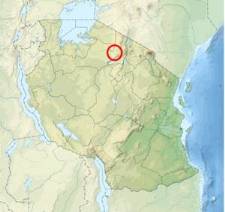
|
|
Location of Olduvai Gorge. Map: Sémhur |
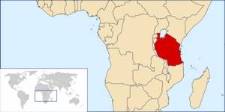
|
|
Location of Tanzania Map: Vardion |
The material on which this hominid is based ranges from about 1.44 to 2.5 million years in age. The first fossils assigned to Homo habilis were discovered in 1960 by Louis and Mary Leakey's son, Jonathan Leakey, at Olduvai Gorge in northwestern Tanzania (then Tanganyika), where his parents had been searching for hominid remains since the 1930s. This material, now known as OH 7 ("Olduvai hominid 7"), was 1.75 million years old. The remains included a mandible, with 13 teeth, two parietal bones, and twenty-one small bones from the hands.¹
Another more complete specimen, a 1.89-million-year-old skull, was found in 1972 by Bernard Ngeneo, of Richard Leakey's "Hominid Gang," near Lake Turkana in Kenya. Known as skull 1470, it had a cranial capacity of about 750 cc. Homo habilis' brain was thus about half as large as that of a modern human.
Homo habilis is the oldest hominid assigned to the genus Homo, and perhaps the least similar to extant humans (Homo sapiens), except perhaps Homo rudolfensis. But its facial structure and small teeth (both fairly similar to those of modern humans), its large cranial capacity, and the precision of its grip (suggested by the hand bones) have convinced most paleoanthropologists that habilis should be placed in Homo. Indeed, many initially believed H. habilis skulls looked too modern to be of such great age. Primitive stone tools often accompany the remains of hominids of this sort, but there is no clear evidence of the use of fire.
Homo habilis: Incertae sedis
Living H. habilis individuals were short — males stood no more than 1.3 m (4 ft 3 in) tall — and had apishly long arms. Certain researchers have asserted H. rudolfensis was more apelike than H. habilis, and that it therefore must have been ancestral to the latter. This is certainly questionable since the earliest fossils of H. habilis are much older than those of H. rudolfensis.
Another hominid, Homo georgicus, recently discovered in the Republic of Georgia, was also a contemporary of late H. habilis. The two were similar in size and cranial capacity (possibly the two have been treated separately only because of the wide separation of their sites of discovery).
It has often been suggested that H. habilis was ancestral to Homo erectus. But recent findings indicate the two coexisted for about 500,000 years.² The most recent H. habilis remains known date to 1.44 million years ago, while the earliest material assigned to H. erectus dates to about two million years ago. So it seems unlikely that H. habilis was the ancestor of H. erectus. As is usually the case with distinct types of hominids, the exact nature of their relationship remains unresolved.
Perhaps we are not from the apes alone?
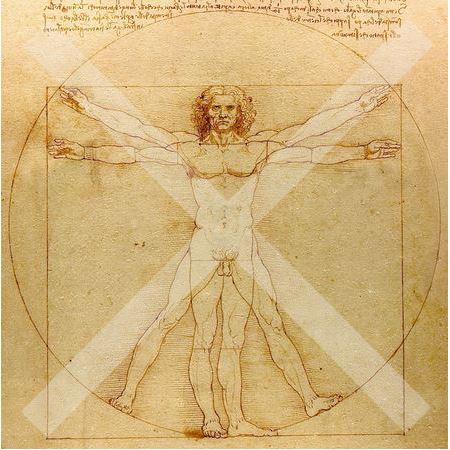
|
|
Etymology: The Latin word homo means "man," or "human being," while habilis means handy, apt, or fit. So the literal meaning of Homo habilis is "handy man" — Usually, however, the meaning of Homo habilis is given as "skillful man," which is not strictly accurate since the Latin expresses skillful with such words as callidus, daedalus, dexter, faber, and peritus, and not habilis. Pronunciation: HŌM-ō HAB-ə-ləs. Classification: All non-australopithecine remains from Olduvai Gorge have been assigned to H. habilis, whereas those from Lake Turkana are attributed to either H. habilis or Homo rudolfensis. |
References:
Interesting facts about other members of genus Homo:
Australopithecus bahrelghazali >>
Most shared on Macroevolution.net:
Human Origins: Are we hybrids?
On the Origins of New Forms of Life
Mammalian Hybrids
Cat-rabbit Hybrids: Fact or fiction?
Famous Biologists
Dog-cow Hybrids
Georges Cuvier: A Biography
Prothero: A Rebuttal
Branches of Biology
Dog-fox Hybrids